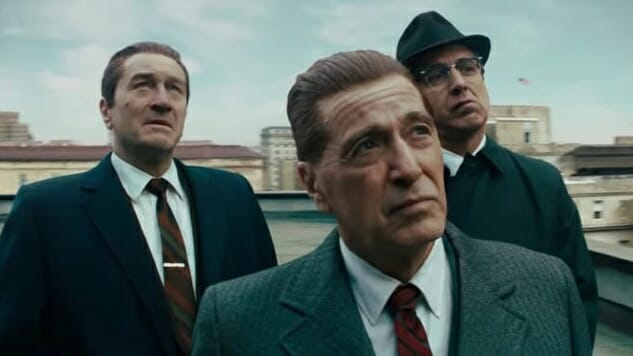Time and the Female Gaze Combine to Wither the Soul in The Irishman

Peggy Sheeran (Lucy Gallina) watches her father, Frank (Robert De Niro), through a door left ajar as he packs his suitcase for a work trip. In go trousers and shirts, each neatly tucked and folded against the luggage’s interior. In goes the snubnose revolver, the ruthless tool of Frank’s trade. He doesn’t know his daughter’s eyes are on him; she’s constitutionally quiet, and remains so throughout most of their interaction as adults. He shuts the case. She disappears behind the door. Her judgment lingers.
The scene plays out one third of the way into Martin Scorsese’s new film, The Irishman, named for Frank’s mob world sobriquet, and replays in its final shot, as Frank, old, decrepit and utterly, hopelessly alone, abandoned by his family and bereft of his gangster friends through the passage of time, sits on his nursing home bed. Scorsese, more so than many filmmakers and indeed most of his critics, understands that the art of directing doesn’t mean moving the camera within cinematic space, as if trying out for an Olympic event or performing parkour; he knows where the camera is supposed to be and leaves it there, in this case the door to Frank’s room, once more left ajar. He sits and he waits. Maybe he’s waiting for Death, but most likely he’s waiting for Peggy (played as an adult by Anna Paquin), who disowned him and has no intention of forgiving him his sins.
Peggy serves as Scorsese’s moral arbiter. She’s a harsh judge: She renders her opinion of Frank early and never finds reason to overrule her verdict, try as he might in his old age to seek absolution from her. Women don’t play as straightforward and immediate a role in The Irishman as men, but all that’s for the best: The film takes a dim view of machismo as couched in the realm of mafiosos and mugs, men who, having been born babies and realizing that they liked being babies, refuse to grow out of it. When Scorsese’s principal characters aren’t scheming or paying off schemes in acts of violence, they’re throwing temper tantrums, eating ice cream, or in an extreme case slap-fighting in a desperately pathetic throwdown. This scene echoes similarly pitiful scenes in Akira Kurosawa’s Drunken Angel and Rashomon: brawls between wannabe roughs afraid of brawling, but forced into it by their own bravado.
-

-

-

-

-

-

-

-

-

-

-

-

-

-

-

-

-

-

-

-

-

-

-

-

-

-

-

-

-

-

-

-

-

-

-

-

-

-

-

-








































